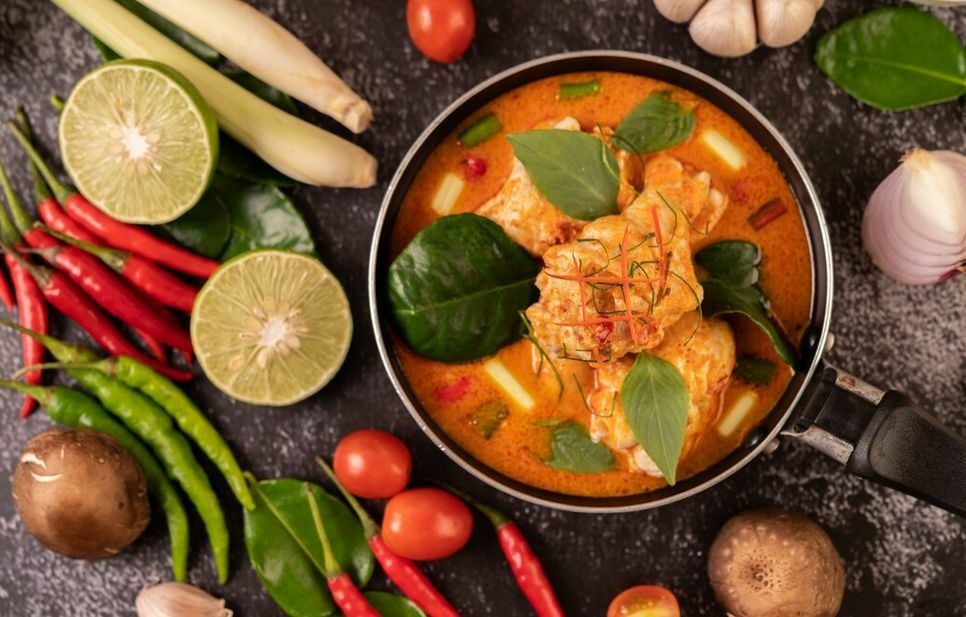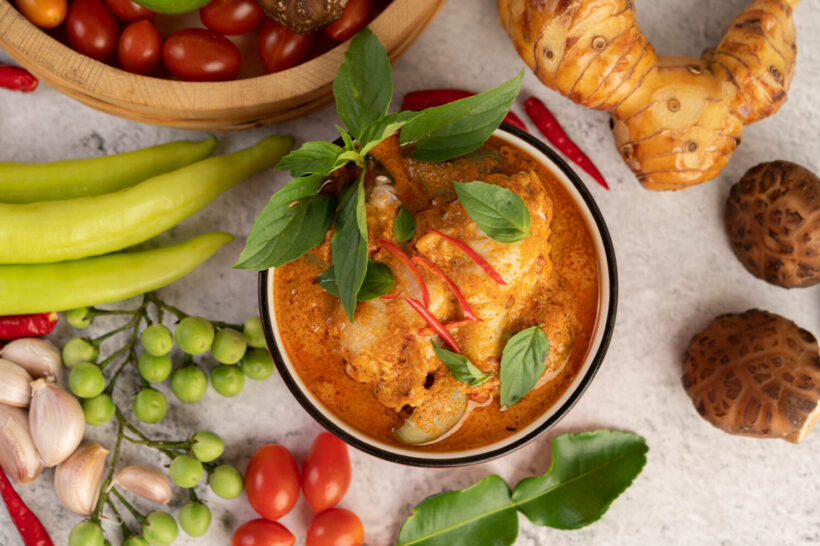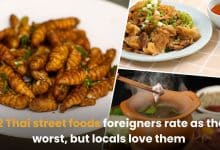Everything you need to know about Thai curries

If you’re a fan of Thai food, chances are, you’ve probably already tried at least a variation of Thai curry. After all, curries are an important part of Thai food. But what exactly is Thai curry? What makes them so rich and tasty? What are the varieties of Thai curry? And what makes it so different from Indian curry? Well, make sure to keep reading to find the answer to all of your questions about this flavorful Thai cuisine.
Everything you need to know about Thai curries
What is Thai curry?
The term ‘Thai curry’ can refer to both Thai curry dishes and the Thai curry paste used to make the dish. There is a wide variety of Thai curry in Thailand – green, yellow, red, Massaman, and Panang. Each type of curry consists of different ingredients and offers distinct flavours. However, when broken down to its bare essentials, Thai curry typically consists of curry paste, coconut milk or water, vegetables, meat, seafood, and herbs. The versatile mixture of ingredients in Thai curry offers an explosion of delicious flavour in your mouth!

What is Thai curry paste made of?
Thai curry dishes are always made with curry paste. Traditionally, all Thai curry pastes consist of shrimp pastes, onions, shallots, garlic, galangal, lemongrass, and chillies. One of the main ways the Thai curries differ from one another is the type of chillies used. Some types of curry use dried red chilies, while others may consist of fresh green chillies or yellow chillies. Aside from the chilies, the paste may also include different spices like turmeric, cardamom, pepper, cumin, and coriander seeds. These ingredients enhance each type of curry paste and make them more distinct from one another.
The traditional method of making homemade Thai curry paste is to crush everything together using a mortar and pestle. However, nowadays, many people also use modern tools to make the process faster and easier. The end result between the traditional and modern methods can be different since you usually need to add liquid to the food processor or blender.
To make Thai curry dishes, you have to stir-fry the curry paste first to bring out its flavours before you add other components. In addition to stew and soup, you can also use Thai curry paste as a salad dressing or marinade.
You can make Thai curry pastes at home or buy freshly made ones at the market. Alternatively, you can also buy it at any supermarket around Thailand in ready-to-use packages.

What are the common ingredients?
The common ingredients in Thai curry dishes are meat, fish, and shellfish. Some Thai curry dishes also contain vegetables, fruits, leaves, and even flowers. Thai curry dishes most commonly include Thai eggplant, yardlong beans, and pumpkins.
The ingredients used typically depend on seasonal and regional availability. However, the common ingredients in Thai curry dishes, such as chicken and pork, are easily available any time of the year, all across Thailand. Many types of fish, both saltwater and freshwater species, are also available all year long.
What are the different types of Thai curries?
Thai curry usually gets broken down into 3 main types: green, yellow, and red. The colours come from the colour of the ingredients used in the recipe, particularly the chillies. Besides the three main types, there are 2 other popular curries in Thai cuisine: Massaman and Panang curry.
1. Green curry
When you think of the smell and taste of Thai curry, chances are, green curry is what comes to your mind. It’s the most famous and distinct Thai curry, as it’s the most different from curry found in other countries. In addition, it also stands out as the hottest. Originating from Central Thailand, the green curry uses fresh green chillies as one of its main ingredients. Along with green chillies, green curry also consists of Thai basil, kaffir lime, white pepper, shallots, lemongrass, garlic, coriander root, sea salt, and shrimp paste. It also uses copious amounts of coconut milk and lime juice, which helps make the flavour stronger.
A lot of green curries in Thailand consist of vegetables like sweet basil leaves, green beans, onions, and green eggplant. You can also include any kind of meat in the curry, but chicken and fish balls are the most common. Due to the spices used in the curry paste, Thai green curry dishes are very unique in their flavours.

2. Red curry
Red curry is another hot curry from central Thailand. Heavily spiced with dried red chillies, it has a bright red-coloured appearance and spicy flavour. Before the red chillies are mixed with other ingredients, Thai people usually soak them in water first to remove the bitterness and heat from them. Once the dried red chillies are soaked, it’s then crushed together in a mortar with garlic, shallots, ginger, and lemongrass, creating a soupy but aromatic curry paste. You can then add coconut milk to the paste to produce a delicious, fiery curry dish. Thai red curry is possibly the most versatile of all Thai curry pastes. Therefore, you can find it in a wide range of dishes, such as Thai red curry with chicken and baked salmon in Thai red curry sauce.

3. Yellow curry
Thai yellow curry is milder with a slightly sweeter flavour compared to green and red curry, making it a good curry to try for beginners. It might not be as spicy or oily, but it still tastes as flavorful as other curries found in Thailand. There are a few different versions of Thai yellow curry, but they share one thing in common: lots and lots of turmerics. In addition to turmeric, the primary spices of Thai yellow curry are coriander, cumin, garlic, bay leaves, fenugreek, lemongrass, cinnamon, and cayenne pepper. Most yellow curry dishes are creamier and richer than other curries as they usually contain both coconut milk and coconut cream. Thai people typically make Thai curry dishes with beef or chicken, potatoes, carrots, and onions.

4. Massaman curry
Massaman curry is a popular curry in central and southern Thailand and is known as one of the best dishes in the world. Influenced by many varieties of Indian curry, it’s loaded with spices found in Indian cuisine, like cardamom and cinnamon. Massaman curry paste is made using garlic, lemongrass, red chillies, cloves, shallots, blue ginger, cardamom, nutmeg, cumin, coriander, and cinnamon. Apart from these ingredients, massaman curry also commonly includes shrimp paste, white pepper, and galangal. Coconut milk and kaffir lime leaves are then added to create the sauce. This type of curry is best served with chicken over rice. However, you can also find Massman curry that consists of pork, beef, fish, or vegetable proteins.

5. Panang curry
Originating from Laos, Panang curry is a bit different from other Thai curry. It’s thick, sweet, and salty, with a nutty flavour and the texture of roasted peanuts ground. The curry paste consists of chillies, galangal, coriander, lemongrass, garlic, shrimp paste, and cumin, among others. Typically, the only liquid added to the curry paste is a small amount of coconut milk to keep the roux quite dry. Thai people usually serve Panang curry with beef or chicken, but you can also get it with tofu or vegetables.

How to eat Thai soup
Thai curry are usually eaten with rice. Jasmine rice is the preferred rice type in central and southern Thailand, while sticky rice is more common in northern Thailand. In some cases, curry can also be eaten with roti, which is the Thai version of India’s fried flatbread.
What’s the difference between Thai and Indian ?
There are several major differences between Thai curry and Indian curry. These include:
1. Fresh vs dry ingredients
Thai curry usually starts with a curry paste that consists of fresh ingredients like chillies, lemongrass, lime, garlic, shallots, ginger, and shrimp paste. On the other hand, the base of Indian curry is usually a gravy made from sautéed and blended onions and tomatoes. Indian people usually season the gravy with dry spices like turmeric, red chilli powder, coriander powder, cumin, and cinnamon.

2. Different flavours
While the two cuisines share some ingredients, they have a very distinct taste. Thai curry usually has a brighter flavour. You’ll definitely taste fresh herbs with hints of citrus in Thai curries. In contrast, Indian curries have savoury and hearty flavours. Instead of citrusy, you’ll taste the rich flavours of cinnamon, cumin, cloves, and turmeric. The ingredients in Indian curry blend into each other as a result of a longer cooking time.
3. Coconut milk vs dairy products
Most Thai curries use coconut milk as the base liquid, but only a few Indian curries do.
In Thai curries, the curry paste is sautéed with some oil in a pan, and then coconut milk is added along with meats, vegetables, and fish sauce. The coconut milk adds a slight thickness to the dish while still keeping a soup-like consistency. Although there are Indian curries that use coconut milk as the base liquid, most of them use dairy products like cream or yoghurt as thickening agents.

4. Thai curry tends to be spicier
Both Thai and Indian curries can be spicy, but Thai curry is typically a bit hotter. The dairy products used in Indian curry help reduce the heat, while Thai curry doesn’t have any dairy ingredients to help tame the spiciness. If you’re not a fan of spicy food or just getting started with your Thai food journey, it’s best to start with Thai yellow curry. The yellow curry is usually milder and sweeter when compared to green and red curries. Most restaurants in Thailand and India make their food less spicy for Westerners.
Now that you have the basic knowledge of Thai curries, you’re ready to embark on your Thai culinary exploration. With so many dishes under the Thai curry category, there’s sure to be something for everyone!
If you want to learn more about Thai food, be sure to read our article on Everything You Need to Know About Thai Food.
If you are also a food lover and love exploring different types of cuisine, planning a visit to Thailand to give your taste buds the awesomeness of Thai cuisine, Agoda.com is your very own website that offers booking services at an affordable range. Do check it out to get your bookings done at discounted rates.
Latest Thailand News
Follow The Thaiger on Google News:


























